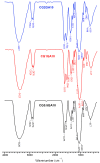Chitosan Sponges with Instantaneous Shape Recovery and Multistrain Antibacterial Activity for Controlled Release of Plant-Derived Polyphenols
- PMID: 36901883
- PMCID: PMC10002852
- DOI: 10.3390/ijms24054452
Chitosan Sponges with Instantaneous Shape Recovery and Multistrain Antibacterial Activity for Controlled Release of Plant-Derived Polyphenols
Abstract
Biomass-derived materials with multiple features are seldom reported so far. Herein, new chitosan (CS) sponges with complementary functions for point-of-use healthcare applications were prepared by glutaraldehyde (GA) cross-linking and tested for antibacterial activity, antioxidant properties, and controlled delivery of plant-derived polyphenols. Their structural, morphological, and mechanical properties were thoroughly assessed by Fourier-transform infrared (FTIR) spectroscopy, scanning electron microscopy (SEM), and uniaxial compression measurements, respectively. The main features of sponges were modulated by varying the CS concentration, cross-linking ratio, and gelation conditions (either cryogelation or room-temperature gelation). They exhibited complete water-triggered shape recovery after compression, remarkable antibacterial properties against Gram-positive (Staphylococcus aureus (S. aureus), Listeria monocytogenes (L. monocytogenes)) and Gram-negative (Escherichia coli (E. coli), Salmonella typhimurium (S. typhimurium)) strains, as well as good radical scavenging activity. The release profile of a plant-derived polyphenol, namely curcumin (CCM), was investigated at 37 °C in simulated gastrointestinal media. It was found that CCM release was dependent on the composition and the preparation strategy of sponges. By linearly fitting the CCM kinetic release data from the CS sponges with the Korsmeyer-Peppas kinetic models, a pseudo-Fickian diffusion release mechanism was predicted.
Keywords: antibacterial activity; chitosan; controlled drug release; curcumin; shape recovery; sponges.
Conflict of interest statement
The authors declare no conflict of interest.
Figures












References
-
- Zhang Z., Qiu C., Li X., McClements D.J., Jiao A., Wang J., Jin Z. Advances in Research on Interactions Between Polyphenols and Biology-Based Nano-Delivery Systems and Their Applications in Improving the Bioavailability of Polyphenols. Trends Food Sci. Technol. 2021;116:492–500. doi: 10.1016/j.tifs.2021.08.009. - DOI
-
- Malacrida C.R., Ferreira S., Zuanon L.A.C., Nicoletti Telis V.R. Freeze-Drying for Microencapsulation of Turmeric Oleoresin using Modified Starch and Gelatin. J. Food Process. Preserv. 2015;39:1710–1719. doi: 10.1111/jfpp.12402. - DOI
MeSH terms
Substances
Grants and funding
LinkOut - more resources
Full Text Sources

